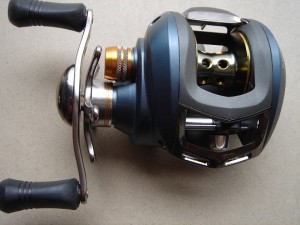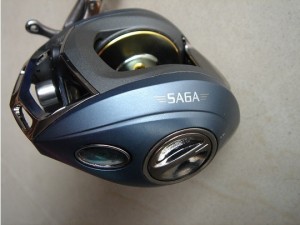First to know the simple definition for baitcaster reel, it has a revoling spool and sits on top of a casting rod with a trigger handle. This is exactly opposite to a spinning reel, which sits underneath a spinning rod and with the line guides facing down.

Fishing baitcast reels designed with both left and right handle model, Many right handed people use right handed reels. However, with this set up, after a cast is made, the reel is placed in your left and the handle is cranked with your right hand. It is the exact opposite for a left handed model. For those that don't want to switch hands, choosing a configuration the same as your fishing spinning reel set up may be the best choice.
Following is the fishing baitcast reels guide
Braking Systems

Baitcast reels come equipped with braking systems. These adjust and slow down the rotation of the spool during the cast.
The spool tension knob is your first line of offense for adjusting spool speed. It is the large knob found on the reel handle side. Tighten this knob enough, so that when you disengage the reel, your lure will slowly fall to the ground. Once it makes contact, the spool should stop revolving almost immediately. The heavier the lure, the tighter the tension should be.
Centrifugal brakes are friction based, and utilize pins inside the side plate of the reel to make adjustments. To engage the brakes, push the pins outward. For a six-pin system, always adjust pins that are across from each other. Both should be either on or off.
No matter what breaking system a reel has, learning to thumb the spool correctly is still your best bet for trouble-free casting. Fine tune each time you're on the water with the various breaking systems, but let your thumb do most of the real work.
Gear ratio
All reels have a gear ratio, it is mean the speed of the reel. When you select one baitcast reel, you will see 5.4:1, 6.4:1, and 7.1:1.and do you know what do these numbers mean? The first set of numbers lists how many revolutions the spool makes for each turn of the reel handle. For instance, with a 6.4:1 reel the spool will revolve 6.4 times with one crank of the handle. The higher the number, the more line that can be retrieved within the same amount of work.
Ball Bearings
Top of the line reels don't necessarily need to have a lot of bearings, just quality ones. Inexpensive reels packed with "10" bearings will often be of poor quality. Key words to look for are "shielded," "double-shielded" and "sealed bearings." These are the top players in the bearing game.
Spools Capacity
The majority of baitcast reels come with an aluminum spool. High-end reels are constructed from forged aluminum, whereas less expensive reels are die-cast. Forged spools are more rigid and harder to scratch. Spools with holes drilled in them are lighter in weight and are easier to stop and start spinning. Most, other than the most inexpensive reels on the market, have drilled spools.
Frames
Come in either aluminum or graphite, with the latter generally less expensive and lighter in weight but not won't withstand much abuse as aluminum. High-end reels are usually manufactured from one-piece aluminum frames.
Line guides
These are made from either titanium or ceramic, with the latter being less expensive but can crack or break from alleviated abuse. High-end reels are usually manufactured with titanium.
Handle
Soft rubber knobs or those designed as oversized work better for many.
More fishing tackle online for sale on Goture.com.
没有评论:
发表评论